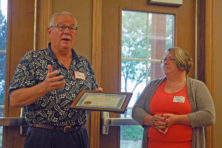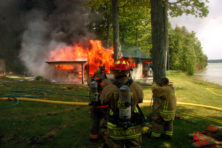Grant Will Hunt for Kangaroo Lake Aquatic Invaders
- Share
- Tweet
- Pin
- Share

The Kangaroo Lake Association (KLA) in February received two grants to pay for a complete survey of plants, including invasive Eurasian watermilfoil that was discovered in the lake in 2016.
The Wisconsin Department of Natural Resources (DNR) grants that will allow the KLA to update the Kangaroo Lake Plant Management plans came in the form of a $6,973 grant for the lake’s shallower, more-diverse north basin, and $8,656 for the south lobe.
Claire Hetzel, water resources management specialist with the DNR Green Bay office, said KLA will hire a consulting firm for the multi-phase projects.
Contractors will create a grid of the entire lake, plot points on the grid and global-positioning systems, and then survey the plant life in each of those locations, she said.
“They will travel to each point, and at each spot they will do a rake toss to capture any and all plants at that point,” Hetzel said. “For a lake like this, that could be a multi-day, multi-crew type of survey.”
In total there were 610 points on the south end of the lake and 401 points on the north end of the lake sampled in 2016.
“As part of our grant these will be re-sampled in 2024 to compare the two to identify any substantial changes to the plant community and assemblage,” said KLA member Kari Hagenow.
Contractors also will do a targeted mapping survey of where Eurasian watermilfoil is present now, and how much its presence spread or shrank in the past six years.
“They have documented Eurasian watermilfoil in the past and I’m sure they will quantify its presence in the lake presently and determine if any further action should be taken,” Hetzel said.
Hagenow said a previous survey showed the greatest population of Eurasian watermilfoil in the shallower north lobe of the lake. It can spread rapidly and become dense and damage fish habitat. She said there was not a very dense population of it five years ago, but she confirmed there is some near the County Road E causeway.
Hagenow’s involvement stems from her association with The Nature Conservancy, which manages much of the land around the north end of th lake.
In 2018, researchers for De Pere-based Onterra reported that Eurasian watermilfoil was the only non-native plant species found in the lake.
The KLA has completed some restoration projects, such as bullrush planting, in an effort to allow native, beneficial plants to outcompete the invasive species.
The projects again spotlight the importance of cleaning boats and trailers each time the boats are launched or removed from a body of water. Aquatic vegetation fragments on boating equipment play the largest role in introducing fragments to new waterbodies, according to the U.S. Fish and Wildlife Service.
Separately, Door County received a $12,371 Lake Monitoring and Protection Network grant. The network supports lake monitoring and aquatic invasive species prevention activities on a county basis and is present in 69 of Wisconsin’s 72 counties.




